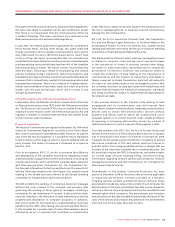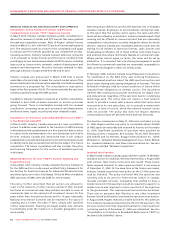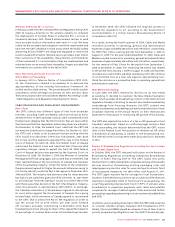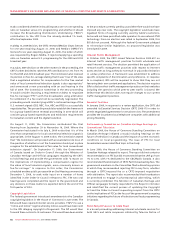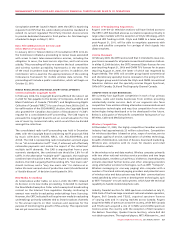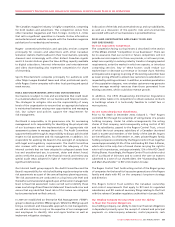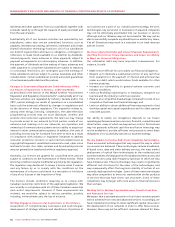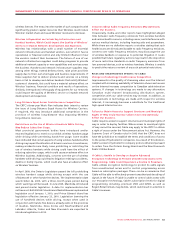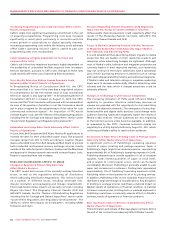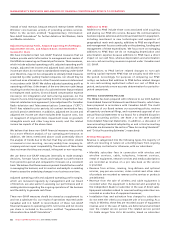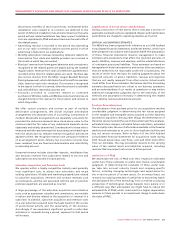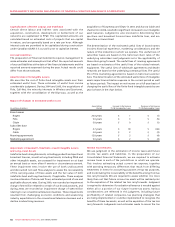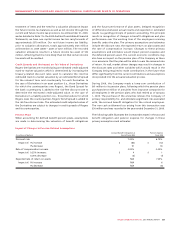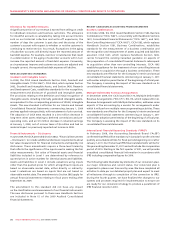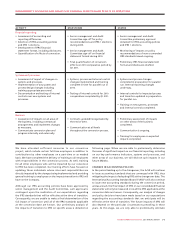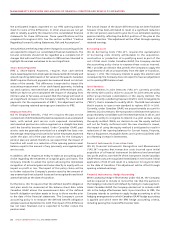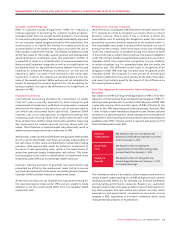Rogers 2009 Annual Report Download - page 59
Download and view the complete annual report
Please find page 59 of the 2009 Rogers annual report below. You can navigate through the pages in the report by either clicking on the pages listed below, or by using the keyword search tool below to find specific information within the annual report.
ROGERS COMMUNICATIONS INC. 2009 ANNUAL REPORT 63
MANAGEMENT’S DISCUSSION AND ANALYSIS OF FINANCIAL CONDITION AND RESULTS OF OPERATIONS
wireless licences. The entry into the market of such companies with
significantly greater capital resources than Wireless could reduce
Wireless’ market share and cause Wireless’ revenues to decrease.
Wireless is Dependent on Certain Key Infrastructure and
Handset Vendors, Which Could Impact the Quality of Wireless’
Services or Impede Network Development and Expansion.
Wireless has relationships with a small number of essential
network infrastructure and handset vendors, over which it has no
operational or financial control and only limited influence in how
the vendors conduct their businesses. The failure of one of our
network infrastructure suppliers could delay programs to provide
additional network capacity or new capabilities and services across
the business. Handsets and network infrastructure suppliers may,
among other things, extend delivery times, raise prices and limit
supply due to their own shortages and business requirements. If
these suppliers fail to deliver products and services on a timely
basis or fail to develop and deliver handsets that satisfy Wireless’
customers’ demands, this could have a material adverse effect on
Wireless’ business, financial condition and results of operations.
Similarly, interruptions in the supply of equipment for our networks
could impact the quality of Wireless’ service or impede network
development and expansion.
Long-Distance Equal Access Could Increase Competition.
The CRTC’s three-year Work Plan indicates their intent to review
the issue of Long-Distance Equal Access for Wireless Carriers.
If required, this may introduce additional competition in the
provision of wireless long-distance thus impacting Wireless’
long-distance revenues.
Restrictions on the Use of Wireless Handsets While Driving
May Reduce Subscriber Usage.
Most provincial government bodies have introduced and/or
enacted legislation to restrict or prohibit wireless handset usage
while driving while permitting hands-free usage. Some studies
have indicated that certain aspects of using wireless handsets while
driving may impair the attention of drivers in various circumstances,
making accidents more likely. Laws prohibiting or restricting the
use of wireless handsets while driving could have the effect of
reducing subscriber usage, which could cause an adverse effect on
Wireless’ business. Additionally, concerns over the use of wireless
handsets while driving could lead to litigation relating to accidents,
deaths or bodily injuries, which could also have an adverse effect
on Wireless’ business.
In April 2009, the Ontario Legislature passed the bill prohibiting
wireless handset usage while driving except with the use
of Bluetooth or other hands-free devices. The implementation date
was October 26, 2009, with a three-month grace period during
which warnings will be issued. In June 2009, Manitoba introduced
and passed similar legislation. A date for implementation has
not been set. Both British Columbia and Saskatchewan implemented
legislation as of January 1, 2010, and Prince Edward Island has
legislation effective January 23, 2010. Legislation banning the
use of handheld devices while driving, except when used in
conjunction with hands-free devices, already exists in the provinces
of Quebec, Manitoba, Nova Scotia and Newfoundland and
Labrador. Alberta, Yukon and New Brunswick are expected to
introduce legislation in 2010.
Concerns About Radio Frequency Emissions May Adversely
Affect Our Business.
Occasionally, media and other reports have highlighted alleged
links between radio frequency emissions from wireless handsets
and various health concerns, including cancer, and interference with
various medical devices, including hearing aids and pacemakers.
While there are no definitive reports or studies stating that such
health issues are directly attributable to radio frequency emissions,
concerns over radio frequency emissions may discourage the use
of wireless handsets or expose us to potential litigation. It is also
possible that future regulatory actions may result in the imposition
of more restrictive standards on radio frequency emissions from
low powered devices, such as wireless handsets. Wireless is unable
to predict the nature or extent of any such potential restrictions.
RISKS AND UNCERTAINTIES SPECIFIC TO CABLE
Changes in Technology Could Increase Competition.
Improvements in the quality of streaming video over the Internet
coupled with increasing availability of television shows and movies
on the Internet increases competition to Canadian cable television
systems. If changes in technology are made to any alternative
Canadian multi-channel broadcasting distribution system,
competition with our cable services may increase. In addition, as
improvements in technology are made with respect to wireless
Internet, it increasingly becomes a substitute for the traditional
high-speed Internet service.
Failure to Obtain Access to Support Structures and Municipal
Rights of Way Could Increase Cable’s Costs and Adversely
Affect Our Business.
Cable requires access to support structures and municipal rights of
way in order to deploy facilities. Where access to municipal rights
of way cannot be secured, Cable may apply to the CRTC to obtain
a right of access under the Telecommunications Act. However, the
Supreme Court of Canada ruled in 2003 that the CRTC does not
have the jurisdiction to establish the terms and conditions of access
to the poles of hydroelectric companies. As a result of this decision,
Cable’s access to hydroelectric company poles is obtained pursuant
to orders from the Ontario Energy Board and the New Brunswick
Public Utilities Board.
If Cable is Unable to Develop or Acquire Advanced
Encryption Technology to Prevent Unauthorized Access to Its
Programming, Cable Could Experience a Decline in Revenues.
Cable utilizes encryption technology to protect its cable signals
from unauthorized access and to control programming access
based on subscription packages. There can be no assurance that
Cable will be able to effectively prevent unauthorized decoding of
signals in the future. If Cable is unable to control cable access with
our encryption technology, Cable’s subscription levels for digital
programming including, premium VOD and SVOD, as well as
Rogers Retail rentals, may decline, which could result in a decline in
Cable’s revenues.


